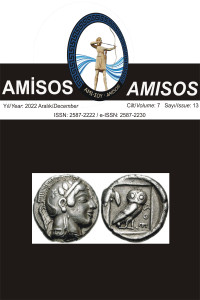Abstract
İnsan doğuştan itibaren çeşitli his, duygu ve yetenekler ile donatılmış, eşsiz bir canlıdır. Kadınlar ve erkekler, kendi doğalarını ve özelliklerini yansıtmalarının yanında, yaptıkları işlerde kullandıkları aletlerle de hemcinslerini temsil etmektedirler. Bu durum Hitit ülkesinde de benzerdir. Hititçe metinlerde erkekler ok ve yay ile temsil edilirken kadınlar ise öreke ve kirman ile temsil edilmektedir. Hatta bu ikililer kadınlığın ve erkekliğin birer göstergesi olarak, metinlerde birlikte kullanılmış ve birer kıyas ölçütü olarak değerlendirilmiştir. Belgelerde GIŠhulali ve GIŠhueša olarak adlandırılan öreke ve kirman, Hitit kadınlığının en önemli sembolleri arasındadır. Kadınların dokuma işlerindeki en büyük yardımcıları olan öreke ve kirman, Hitit ritüellerinde bir erkeğe “erkekliğini geri vermek” ya da bir erkekten “erkekliğini almak” amaçlarıyla kullanılmıştır. Kısacası bu iki alet, erkeğin cinsel iktidarını belirleyici bir rol üstlenmiştir. Asıl kullanıcıları kadınlar olan öreke ve kirman, birçok kez erkeklerin kullandığı aletlere karşılık gelen iki nesne şeklinde kullanılmıştır. Bütün bu özellikleriyle her iki nesne, Hititlerin sosyal, kültürel ve dini hayatında önemli bir yere sahip olmuştur.
References
- Baccelli, G.-Bellucci, B.-Vigo, M. 2014, “Elements for a Comparative Study of Textile Production and Use in Hittite Anatolia and in Neighbouring Areas”, Prehistoric, Ancient Near Eastern and Aegean Textiles and Dress, 97-142.
- Bellucci, B.-Vigo, M. 2014, “Note Sulla Concezione del Post Mortem Presso Gli Ittiti”, Religio Collana di Studi del Museo delle Religioni “Raffaele Pettazzoni”, (Ed. I. Baglioni), 21-36.
- Çilingir Cesur, S. 2019, “Eşyanın Cinsiyeti: Hitit Ritüellerinde Kadın”, TÜBA-AR, 24, 73-89.
Abstract
Human is a unique creature, endowed with various feelings, emotions and abilities from birth. Women and men represent their fellows with the tools they use in their work as well as reflecting their own nature and characteristics. This situation is similar in the Hittite land. In Hittite texts, men are represented with bow and arrow while women are represented with distaff and spindle. In fact, these pairs are used together in texts as indicators of femininity and masculinity and evaluated as benchmarks. Distaff and spindle, called GIŠhulali and GIŠhueša in documents, are among the most important symbols of Hittite femininity. Distaff and spindle, the biggest helpers of women in weaving, were used in Hittite rituals for the purposes of “returning his masculinity” to a man or “taking his masculinity” from a man. In short, these two tools have played a decisive role in the sexual power of men. Distaff and spindle whose main users are women, are often used as two objects corresponding to tools used by men. With all these features, both objects had an important place in the social, cultural and religious life of the Hittites.
References
- Baccelli, G.-Bellucci, B.-Vigo, M. 2014, “Elements for a Comparative Study of Textile Production and Use in Hittite Anatolia and in Neighbouring Areas”, Prehistoric, Ancient Near Eastern and Aegean Textiles and Dress, 97-142.
- Bellucci, B.-Vigo, M. 2014, “Note Sulla Concezione del Post Mortem Presso Gli Ittiti”, Religio Collana di Studi del Museo delle Religioni “Raffaele Pettazzoni”, (Ed. I. Baglioni), 21-36.
- Çilingir Cesur, S. 2019, “Eşyanın Cinsiyeti: Hitit Ritüellerinde Kadın”, TÜBA-AR, 24, 73-89.
Abstract
References
- Baccelli, G.-Bellucci, B.-Vigo, M. 2014, “Elements for a Comparative Study of Textile Production and Use in Hittite Anatolia and in Neighbouring Areas”, Prehistoric, Ancient Near Eastern and Aegean Textiles and Dress, 97-142.
- Bellucci, B.-Vigo, M. 2014, “Note Sulla Concezione del Post Mortem Presso Gli Ittiti”, Religio Collana di Studi del Museo delle Religioni “Raffaele Pettazzoni”, (Ed. I. Baglioni), 21-36.
- Çilingir Cesur, S. 2019, “Eşyanın Cinsiyeti: Hitit Ritüellerinde Kadın”, TÜBA-AR, 24, 73-89.
Abstract
References
- Baccelli, G.-Bellucci, B.-Vigo, M. 2014, “Elements for a Comparative Study of Textile Production and Use in Hittite Anatolia and in Neighbouring Areas”, Prehistoric, Ancient Near Eastern and Aegean Textiles and Dress, 97-142.
- Bellucci, B.-Vigo, M. 2014, “Note Sulla Concezione del Post Mortem Presso Gli Ittiti”, Religio Collana di Studi del Museo delle Religioni “Raffaele Pettazzoni”, (Ed. I. Baglioni), 21-36.
- Çilingir Cesur, S. 2019, “Eşyanın Cinsiyeti: Hitit Ritüellerinde Kadın”, TÜBA-AR, 24, 73-89.
Abstract
References
- Baccelli, G.-Bellucci, B.-Vigo, M. 2014, “Elements for a Comparative Study of Textile Production and Use in Hittite Anatolia and in Neighbouring Areas”, Prehistoric, Ancient Near Eastern and Aegean Textiles and Dress, 97-142.
- Bellucci, B.-Vigo, M. 2014, “Note Sulla Concezione del Post Mortem Presso Gli Ittiti”, Religio Collana di Studi del Museo delle Religioni “Raffaele Pettazzoni”, (Ed. I. Baglioni), 21-36.
- Çilingir Cesur, S. 2019, “Eşyanın Cinsiyeti: Hitit Ritüellerinde Kadın”, TÜBA-AR, 24, 73-89.
Abstract
References
- Baccelli, G.-Bellucci, B.-Vigo, M. 2014, “Elements for a Comparative Study of Textile Production and Use in Hittite Anatolia and in Neighbouring Areas”, Prehistoric, Ancient Near Eastern and Aegean Textiles and Dress, 97-142.
- Bellucci, B.-Vigo, M. 2014, “Note Sulla Concezione del Post Mortem Presso Gli Ittiti”, Religio Collana di Studi del Museo delle Religioni “Raffaele Pettazzoni”, (Ed. I. Baglioni), 21-36.
- Çilingir Cesur, S. 2019, “Eşyanın Cinsiyeti: Hitit Ritüellerinde Kadın”, TÜBA-AR, 24, 73-89.
Abstract
References
- Baccelli, G.-Bellucci, B.-Vigo, M. 2014, “Elements for a Comparative Study of Textile Production and Use in Hittite Anatolia and in Neighbouring Areas”, Prehistoric, Ancient Near Eastern and Aegean Textiles and Dress, 97-142.
- Bellucci, B.-Vigo, M. 2014, “Note Sulla Concezione del Post Mortem Presso Gli Ittiti”, Religio Collana di Studi del Museo delle Religioni “Raffaele Pettazzoni”, (Ed. I. Baglioni), 21-36.
- Çilingir Cesur, S. 2019, “Eşyanın Cinsiyeti: Hitit Ritüellerinde Kadın”, TÜBA-AR, 24, 73-89.
Details
| Primary Language | Turkish |
|---|---|
| Journal Section | MAKALELER / ARTICLES |
| Authors | |
| Publication Date | December 26, 2022 |
| Submission Date | November 26, 2022 |
| Acceptance Date | December 24, 2022 |
| Published in Issue | Year 2022 Volume: 7 Issue: 13 |
Tarihi aydınlatabilmek ümidi ile...
.................AMİSOS.................


